Frigiliana Tourist Information

There's my house! It's that one there with the whitewashed walls and red tiled roof!
The Village
Frigiliana is arguably the whitewashed Andalucian village of historical, cultural and architectural reference in the province of Malaga, and possibly one of a collection of the best in Andalucia.
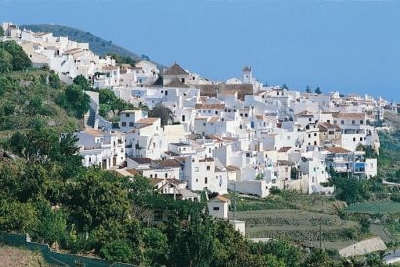
A view of a glistening, whitewashed Frigiliana in the Spanish sun.
Nestled partly on a mountain ridge and flank at an altitude of approximately 400 metres and just 7 kilometres inland from the coastal resort of Nerja, Frigiliana has a population of approximately 3,000 and still remains rural, quaint and relaxed. It is also located in the Natural Park of Almijara, Tejeda and Alhama and has a recognised subtropical climate with distinct seasons though not extreme.
Frigiliana is not a nucleated village, rather, it is linear and follows the contour of the mountain slope on which it was built. This makes moving around the old town a lot easier especially if one intends to frequent the village. Having said that, although there are many good restaurants, shops and places of interest along the main street or within effortless reach, let's not forget that Frigiliana is a mountain village. To explore deeper into the village and see what charming and impressive things there are to discover, you will inevitably have to do some climbing.
There are two main thoroughfares in the old town: there is the original, narrow, cobble-stoned main street, Calle Real, which begins its winding course from the 16th century sugarcane factory and continues through the old town until it emerges on the other side by the artisanal olive processing plant. And then there is the newer, wider road built a few years ago which passes around the village and has parking on both sides.
From the villa, it really does not take that long to get into village on foot and arrive at any point within. The village is actually split into two distinct and separate parts: the old historical quarter, which is the part closest to the villa, and the new town.
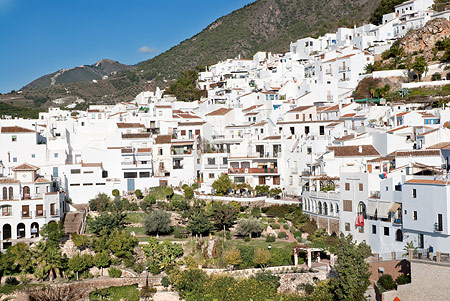
A spritely looking Frigiliana showcasing its very own tropical botanic garden.
The Arabs had a hugely important influence on Frigiliana. Nowhere is this more blatantly evident than in its architecture. Of all the villages in the province of Malaga, Frigiliana is considered to be the best remaining and preserved example of this. In fact, it is the village with the most awards both in the Axarquia region and the province. In 1961 and 1967, it was awarded the 1st and 2nd prize, respectively, for the Provincial Award for Beutification of Villages in Malaga. In 1982 it won the first prize for the National Award of Beautification and Improvement of Villages in Spain. In 1988 it was also awarded the first prize for the Improvement and Beautification of Andalucian Villages.
A Very, Very Succinct History
Frigiliana occupied an important place in Spanish history during the expulsion of the Moors. The village retains one of the most authentic manifestations of traditional moorish architecture in Spain seen in its Moorish Quarter or High Quarter.
Inhabited since 3000 BC, it was also the site of settlements established by the Phoenicians and Romans. They built a fortress and gave it the name of "property or town of Frexinius" by which the town has been known ever since. However, the origin of the town as such dates back to to the 9th and 10th centuries with the construccion of a castle (nonexistant) around which a small enclave developed. This spot would have been known as Hins Challana in Caliphal times and as Fixmiana during Nazarine (Moorish) rule.
Like many other villages of the Almijara and Alpujarra (Granada) mountain ranges, the main economic activity of Frigiliana was the production of silk, olives and its derivatives, grapes and figs. After the fall of the kingdom of Granada and during the reign of the Catholic Kings, the population continued being Muslim and its way of life and customs didn't change much at all.
However, as time went by, the increasing domination and control to which the Moors were subjected by the Christians created increasing problems and disagreement, mostly because of the excessive taxes imposed upon the Moors and the ever increasing restrictions placed on their religious beliefs and social practices. Consequently, and as in many other villages in the Christian kingdom, the Moors of Frigiliana rose up against the royal authority.
The fortress and settlement of Frigiliana dominated the landscape and the Almijara mountain range, being an area of difficult access and serving as an effective natural defensive barrier. It's not surprising that many Moorish rebels took advantage of this difficult landscape and sought refuge there in 1568 while at the same time planning the great and famous battle, which is expressively narrated on many plaques situated around the present day village. In the final battle, the troops of Luis de Requesens were victorious and the Moors were expelled from their land and forced to scatter and settle elsewhere in the southern Iberian peninsula. Legend has it that many of the Moorish women, upon discovering that the Christians had won the decisive battle, rather than be captured by the Christians, threw themselves over the cliffs.
During the 17th century, Frigiliana suffered a period of inactivity with a population not much bigger than a hundred individuals. In May of 1640, Inigo Manrique de Lara was named Count of Frigiliana. The expulsion of the Moors meant that silk production was abandoned, from which point in time the main economic activity became the cultivation of sugar cane. Testimony to this is the largest building in the village dating to the 16th century, El Ingenio, the only remaining sugar factory in Europe still in production. From this period also are the Palacio del Apero, presently used as the village library and museum; and the church of San Antonio.
Under the reign of Philip IV, the village acquired the title of town, and only many years later towards the end of the 19th century, did it finally grow to a population of about 3,000.
Places to Visit
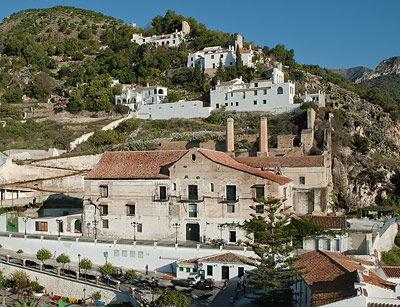
Last remaining sugarcane factory in production in Europe.
El Ingenio
Building constructed at the end of the 16th century as a noble house by the Manrique de Lara family, nobility in Frigiliana since 1508. It is of the Renaisance style and stands on two thousand square metres of land. Many of the prominent architectural features of the building were collected from the destroyed arab castle. Some of these items include balconies, wrought iron grills, sun dials as well as the beatuiful mural paintings on the walls. Today it houses the only existing cane sugar factory in Europe, as well as an olive mill that still processes the olives using traditional methods.
La Ermita de Ecce Homo (The chapel of Ecce Homo)
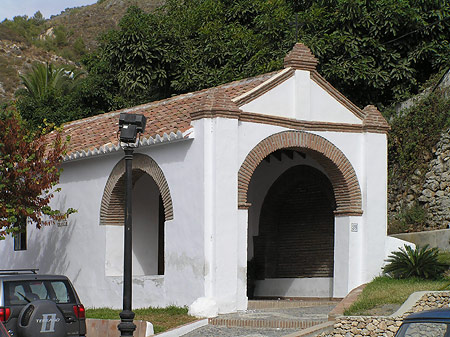
The chapel of Ecce Homo.
The chapel of Ecce Homo, or chapel of Holy Christ of the Cane as it is known by the townsfolk, is a place of great cultural interest and for understaning the tradition of the baroque christian festivals celebrated during the Easter period in Frigiliana. The procession through the streets of the various effigies representative of the christian faith has been a tradition in Frigiliana since the 16th centruy. However, the effigies that are carried through the streets nowadays are neobarroque from the 20th century, and it is difficult to establish exactly when they were made or from which period they date. Nevertheless, they are testimony to the longevity of the tradition in the village. On Ash Wednesday there is a procession from the chapel to the Iglesia de San Antonio where there is a carving of Ecce Homo, a multicoloured piece of wood in the neobarroque style made in the second half of the 20th century.
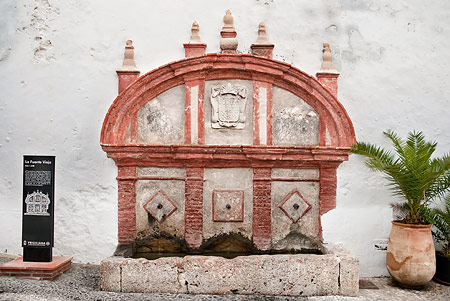
Fuente Vieja stone water fountain and trough.
Fuente Vieja (The Old Fountain)
The fountain dates from the 17th century and was constructed by Don Inigo Manrique de Lara, fifth Lord of Frigiliana and first Count of Frigiliana in the year 1640, and on which his family shield can be found. It is attached to the back of a house and was built there in order to provide water for the village and as a watering trough for animals. Curiously, it was oringinally known as "The New Fountain". Passing through the old town one may find the Fuente Vieja on Choruelo street.
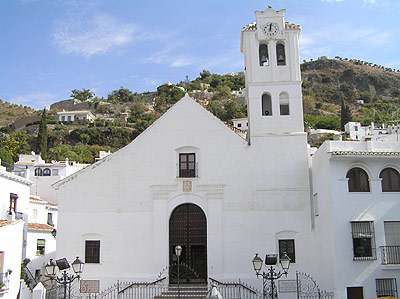
The proudly standing 17th century church of Saint Anthony of Padua - the fulcrum of the village.
Iglesia de San Antonio de Padua (Church of Saint Anthony of Padua)
Built in 1676 over the site of an earlier mosque and restored a century later, it was financed by the Manrique de Lara family and finished in 1676 by Bernardo de Godoy.
It is in almost all of its entirety built in the Renaissance style and many of the original frescos can still be seen throughout, not to mention three 17th century paintings of excellent quality. There is a plaque at the entrance that details the story of its construction.
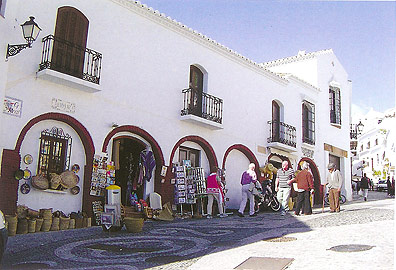
Ancient granary silos which are now modern day homes and shops.
Reales Positos (Royal Silos)
Ancient silos constructed in 1767 where the excess grain from surplus production in any given year was stored and later distributed during years when grain production was poor. Although the silos are mentioned in historical records from 1749 onwards, it is very possible that it was introduced in 1640, the year in which Frigiliana was declared an independent village. Nowadays, the silos are now replaced by privately owned houses, having conserved the original structure of prominent red brick arches on its facade and its less visible basement chambers underneath.
El Torreon
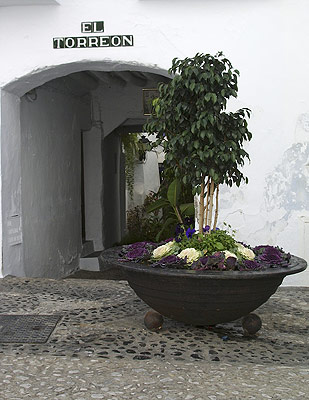
El Torreon - watch tower, arab edifice or archaeological conundrum?
This is the place where the silo was found in the middle of the 18th century and which in the present day is next to a house. Against what was previously speculated until now, it appears improbable that its origin is arab since the truncated construccion does not offer any similarities with the architectural style expected of this period. More probable is that it could be a later construction of the type that became abundant during the 18th century serving as a watch tower against pirates.
El Castillo (The Castle)
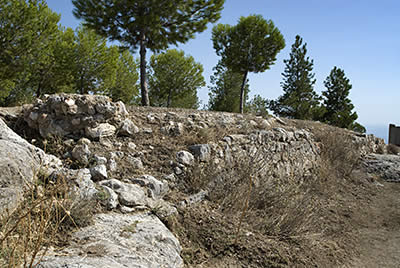
Ruins of the military fortress witness to one of the most famous and brutal battles between Moors and Christians.
Constructed probably around the 11th century as a military fortress, it took up a surface area of 4000m2. The Battle of Frigiliana resulted in its almost complete destruction on the part of the Christians with the objective being to avoid that the Moors were able to return and rearm within the fortress walls. After its destruction, the only remaining remnants are some foundations and broken sections of wall and the acces ramp leading up to the fortress.
Casa del Apero
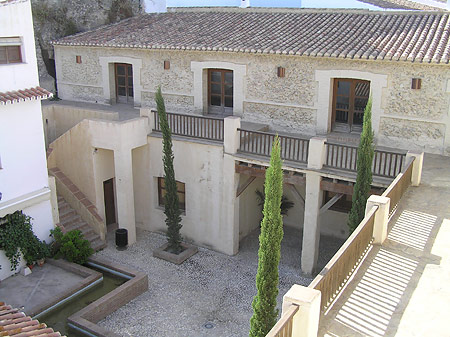
Casa del Apero: the versatile, dynamic, do-all, multipurpose centre; past present and future. A modern day reference and one-stop shop. Simply and unbelievably amazing.
It was probably at the beginning of the 17th century when this building was constructed to form part of the working operations of El Ingenio (sugarcane factory). It was put to use as a granary, stables and warehouse for storing field tools and machinery. It is a rectangular building with an interior patio and built in two levels with mud walls. The arches and pillars are constructed from bricks in the same way as the main entrance.
After its restoration in the 90's, it was put to use as a Cultural Centre "Casa del Apero" which houses the village library, the archaeological museum, exposition hall and gallery, the historical archive and the tourist information centre.
Barrio Mudejar (Moorish Quarter)

One of 12 plaques dotted around the village, telling the story of the Battle of Frigiliana between the Moors and Christians.
The Moorish Quarter is in the old town of Frigiliana and represents a monument in itself, which some critics have classified as "the best example of an architectural ensemble of buildings of arab origin that exists in the province of Malaga. This is not surprising as Frigiliana is the village with most number of awards for its high level of conservation and beutification.
Worth mention also are the twelve tiled panels that can be found along a specific route through the old village that describe the famous Battle of Frigiliana which marked the definitive end of the existence of the Moors in the Iberian peninsula.
Geography, Surroundings and Weather
Frigiliana has an area of approximately one square kilometre and is located in the foothills on the south face of the Almijara mountain range, guaranteeing views of the Mediterranean Sea from almost any point. Frigiliana is only 6 kilometres from the resort town of Nerja on the coast below. Travelling east from Malaga along the Costa del Sol, Frigiliana is the easternmost village in the province yet it is only 60 kilometres from the provincial capital Malaga and 26 kilometres from the regional capital of the Axarquia, Velez-Malaga.
- Days of Sunshine: 300 days / year
- Average temperature: 18 0 C
- Hours of sunshine: 2950 hours / year
- Rainfall: 590 l / m2/ year
For detailed, indepth and up to the minute weather information, go to the Spanish Meteorological Agency website which is without doubt the best weather information service in Spain. The link will take you straight through to the English version of the website.
Shops and Local Produce
There are many shops in the village offering a relatively diverse selection of products and items, some of it generic but a lot of it artisanal and locally made.
For locally grown fruit and vegetables and other basic items, there are a number of little shops or mini-markets in the village all providing a decent selection of locally grown produce. The largest of these mini-markets is coincidentally the closest to the villa and is only a short walk away. This mini-market also sells bread, frozen meats, spirituous liquor, chilled dairy products and general merchandise. There is also an in-house delicatessen where they will prepare sandwiches or "bocadillos."
Thursdays in Frigiliana means MARKET DAY and is held in the centre of the village on the roof of the new public parking building, in front of the bus stop and main roundabout. It is always heaving with people and there are many stalls with clothes, shoes, food and various other goods on sale. don't miss out on paying Antonio a little visit. He's the fruit and veg man and sells straight out of his van. He almost always will tell you, "1 euro per kilo", but he almost always will give you a lot more than one kilo.